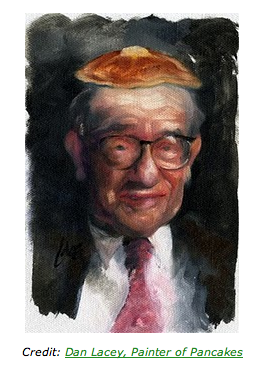Should Investors Boycott the Stock Market?
 Courtesy of Frederick Sheehan of AuContrarian Blog
Courtesy of Frederick Sheehan of AuContrarian Blog
Investing in stocks is marketed as believing in America. Imbedded is the assumption that buying stocks is a fair deal. An investor might make or lose money, but the same chance was taken by all participants.
Although they have received little notice, the recently released 2004 Federal Reserve Open Market Committee (FOMC) transcripts show how the Fed was channeling its attention and distorting markets for the benefit of favored institutional investors. (See AuContrarian.com "blog" The 2004 Fed Transcripts: A Methodical, Diabolical Destruction of America’s "Wealth".) The 2004 Transcripts were not so much a revelation as a confirmation. The Fed’s valiant attempt to prevent the economy from deflating (its claim at the time) by inflating asset markets is now a matter of public record. FOMC members explicitly stated they were working with hedge funds and pushing housing prices up.
We know how this ended. The Fed’s policy was successful until 2007. Then all asset prices collapsed, along with the institutions (banks and brokerages) that believed the Fed could prevent prices from ever falling. The backstop was known as the "Greenspan Put:" the belief that Chairman Greenspan’s Fed would always prevent market prices from falling.
A put option gives the buyer an option (a choice) to sell a security at a price previously negotiated with the seller. A put option is valuable if prices fall below the level of the negotiated price. An investor can buy a put with the right to sell the S&P 500 Index at 800. If the Index rises to 1100, the option is worthless. (Why sell it for $800 when it can be sold in the market for $1100?) If the S&P 500 Index falls to 600, the value of the put option is worth at least $200 to the owner of the put: the Index is trading for $600 but can be sold for $800. The put option is an insurance policy against a stock market collapse. The need for the average investor to understand such instruments will be discussed below.
.png) The Greenspan Put begat the Bernanke Put, once the latter became chairman in 2006. Believers in the Put have reason for such faith. The 2004 transcripts show the FOMC toiled to fulfill this zeal. The zealots ignore the failure of the Put in 2007 and 2008.
The Greenspan Put begat the Bernanke Put, once the latter became chairman in 2006. Believers in the Put have reason for such faith. The 2004 transcripts show the FOMC toiled to fulfill this zeal. The zealots ignore the failure of the Put in 2007 and 2008.
The credit collapse of 2007 and 2008 ended as all government-sponsored market support programs have ended. In 2010, the federal government’s interference in markets is ten-fold, or possibly, one-hundred-fold, greater than in 2004. Distortions created by Fed interference in 2004 (such as, the mortgage market) went hand-in-hand with the collapse in 2007. Given the Fed’s iron grip on markets today, the imbalances are much greater. Investors need to plan now for when the contrivances shatter.
The busybodies’ catalogue would start with their zero-percent federal funds rate. This is not only an inducement to borrow without fear, it is also part of the Federal Reserve’s program to suck the unwashed into higher risk investments, such as the stock market and municipal bonds. Federal Reserve Governor Donald Kohn stated in the autumn of 2009: "[R]ecently the improvement, in risk appetites [have] respond[ed] to actions by the Federal Reserve and other authorities…. Low market interest rates should continue to induce savers to diversify into riskier assets…."(For more on this, see AuContrarian blogs: March 9, 2010:From the Greenspan Put to the Kohn Put: Our Brilliant Central Bankers and March 25, 2010: Government Authorities are Looking Out for Themselves – As Should Everyone.)
Investors should be aware of other means by which the Fed and other authorities are interfering with markets, since the mutations have created phony prices. Again, as we saw in 2007 and 2008, the compounding of illusionary prices finally collapsed.
Four sources of phony prices follow.
First, interest rates are distorted. At one percent (and less) speculators gamble and push up asset prices.
Second, is the housing market. It does not exist. The authorities have warned us. The latest was David Stevens, head of the Federal Housing Administration, who told an audience on May 24, 2010, the housing market is a "government-financed market" that is "purely on life-support, sustained by the Federal government." House prices will sink when the government runs out of lifeboats.
Third, the authorities have handed the stock market to institutions where the computers buy and sell. The Financial Times reported that only 3% of stock market trading is by retail customers. Tradebot, in Kansas City, Missouri, holds stocks for an average of 11 seconds. It made money every day for four years. (See: "Speedy New Traders Make Waves Far From Wall St," New York Times, May 16, 2010)
Fourth, the Federal Reserve is manipulating the currency markets, as Rainer Bruederle, German finance minister, disclosed on May 28. Angst should border on panic, given the man in charge of this operation. The last time the Federal Reserve did so, in July 2009, Congressman Alan Grayson asked Federal Reserve Chairman Ben Bernanke to whom the Fed had lent $500 billion. The chairman had no idea. Bernanke claimed, legitimately, loan collection was the responsibility of the central banks that had received the funds. His detachment is in keeping with the man’s tendency to wander through vague abstractions, yet for those weighing the destination of their life savings, or, whether to buy a house or hide in a cave, Simple Ben is a dangerous obstacle to logical thinking.
In the 1970s, many in the United States knew little about personal finance other than the beauty of compound interest. It was during that decade when double-digit inflation chased those who were quick enough into certificates of deposits. The latecomers who did not adapt were left behind.
From certificates of deposit, the household has adapted to changing times (or, been left behind). Now, it is necessary to understand protection, which should not be confused with asset diversification. The put option described above is a potential instrument. There are other approaches; the costs of each should be weighed and this needs to be emphasized: all insurance is a cost.
 This leads back to the title: "Should Investors Boycott the Stock Market?" In the current discussion: what is the cost of abandoning stocks, and, for instance, ducking inside a savings account?
This leads back to the title: "Should Investors Boycott the Stock Market?" In the current discussion: what is the cost of abandoning stocks, and, for instance, ducking inside a savings account?
For all Bernanke’s faults, there is at least a consistency about the man. His mind is as inflexible as a Prussian border guard’s. In 1999, he wrote: "A central bank can… extend loans to depositories, other financial intermediaries, or firms and households…. This may be particularly helpful in spurring aggregate demand should the financial sector be under stress and in need of liquefying its assets." [My italics.] If Bernanke sees the economy sinking, there is nothing to stop the mad professor who dreamt up this conflagration from electronically wiring $100,000 to every American’s personal checking account. The Dow could pass 100,000 shortly after.
In conclusion, investors need protection on the downside and exposure to the upside. At the moment, the prospect of a stock market crash looks more likely.
Frederick Sheehan is the author of Panderer to Power: The Untold Story of How Alan Greenspan Enriched Wall Street and Left a Legacy of Recession (McGraw-Hill, 2009).
Artwork courtesy of Jr. Deputy Accountant


